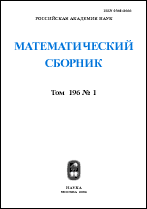|
This article is cited in 9 scientific papers (total in 9 papers)
The defects of admissible balls and octahedra in a lattice, and systems of generic representatives
A. M. Raigorodskii
M. V. Lomonosov Moscow State University
Abstract:
Let ${\mathscr E}=O\,\mathbf e_1,\dots,\mathbf e_n$ be the frame of unit coordinate vectors, let $\Lambda \subset \mathbb R^n$ such that ${\mathbb Z}^n\subset \Lambda$, let ${\mathscr O}_{\mathscr E}^n$ be the unit octahedron, and let ${\mathscr B}_{\mathscr E}^n$ be the unit ball. A set $\Omega \in \{{\mathscr O}_{\mathscr E}^n,{\mathscr B}_{\mathscr E}^n\}$ is said to be admissible in $\Lambda$ if $\Omega \cap \Lambda =\{O,\pm \mathbf e_1,\dots ,\pm \mathbf e_n\}$. The defect $d(\Omega;\Lambda)$, with respect to $\Lambda$, of a set $\Omega$ admissible in $\Lambda$ is the smallest number of vectors to be deleted from ${\mathscr E}$ in order that the remaining system can be complemented to a basis in $\Lambda$. Let $d_n(\Omega)=\max _\Lambda d(\Omega;\Lambda)$ and let $d_n^*(\Omega)=\max _\Lambda ^*d(\Omega;\Lambda)$, where the maximum is taken over all $\Lambda$ in the first case and over all $\Lambda$ such that $\Lambda /{\mathbb Z}^n$ is a cyclic group in the second. It is shown that $d_n^*(\Omega)\gg \frac n{\log n}(\log \log n)^2$ and $d_n(\Omega)\geqslant n-c\frac n{\log n}$, where $c$ is an absolute constant.These results are obtained using methods of geometry and combinatorial analysis.
Received: 31.10.1996
Citation:
A. M. Raigorodskii, “The defects of admissible balls and octahedra in a lattice, and systems of generic representatives”, Sb. Math., 189:6 (1998), 931–954
Linking options:
https://www.mathnet.ru/eng/sm328https://doi.org/10.1070/sm1998v189n06ABEH000328 https://www.mathnet.ru/eng/sm/v189/i6/p117
|


| Statistics & downloads: |
| Abstract page: | 661 | | Russian version PDF: | 304 | | English version PDF: | 21 | | References: | 76 | | First page: | 1 |
|




 Contact us:
Contact us: Terms of Use
Terms of Use
 Registration to the website
Registration to the website Logotypes
Logotypes







 Citation in format
Citation in format 
